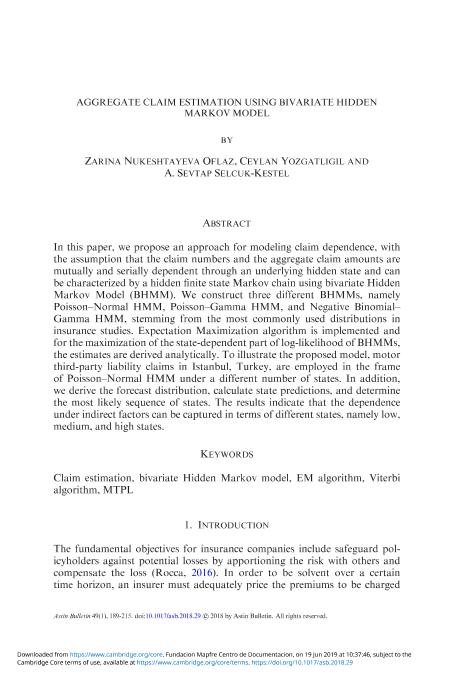Aggregate claim estimation using bivariate hidden Markov model

Contenido multimedia no disponible por derechos de autor o por acceso restringido. Contacte con la institución para más información.
| Tag | 1 | 2 | Valor |
|---|---|---|---|
| LDR | 00000cab a2200000 4500 | ||
| 001 | MAP20190019156 | ||
| 003 | MAP | ||
| 005 | 20190625124237.0 | ||
| 008 | 190619e20190101gbr|||p |0|||b|eng d | ||
| 040 | $aMAP$bspa$dMAP | ||
| 084 | $a6 | ||
| 100 | 1 | $0MAPA20190008181$aNukeshtayeva Oflav, Zarina | |
| 245 | 0 | 0 | $aAggregate claim estimation using bivariate hidden Markov model$cZarina Nukeshtayeva Oflav, Ceylan Yozgatligil, A. Sevtap Selcuk-Kestel |
| 300 | $a27 p. | ||
| 520 | $aIn this paper, we propose an approach for modeling claim dependence, with the assumption that the claim numbers and the aggregate claim amounts are mutually and serially dependent through an underlying hidden state and can be characterized by a hidden finite state Markov chain using bivariate Hidden Markov Model (BHMM). We construct three different BHMMs, namely PoissonNormal HMM, PoissonGamma HMM, and Negative BinomialGamma HMM, stemming from the most commonly used distributions in insurance studies. Expectation Maximization algorithm is implemented and for the maximization of the state-dependent part of log-likelihood of BHMMs, the estimates are derived analytically. To illustrate the proposed model, motor third-party liability claims in Istanbul, Turkey, are employed in the frame of PoissonNormal HMM under a different number of states. In addition, we derive the forecast distribution, calculate state predictions, and determine the most likely sequence of states. The results indicate that the dependence under indirect factors can be captured in terms of different states, namely low, medium, and high states. | ||
| 650 | 4 | $0MAPA20080602437$aMatemática del seguro | |
| 650 | 4 | $0MAPA20080576783$aModelo de Markov | |
| 650 | 4 | $0MAPA20080567118$aReclamaciones | |
| 700 | 1 | $0MAPA20190008198$aYozgatligil, Ceylan | |
| 700 | 1 | $0MAPA20190008204$aSevtap Selcuk-Kestel, A. | |
| 773 | 0 | $wMAP20077000420$tAstin bulletin$dBelgium : ASTIN and AFIR Sections of the International Actuarial Association$x0515-0361$g01/01/2019 Volumen 49 Número 1 - enero 2019 , p. 189-216 |

